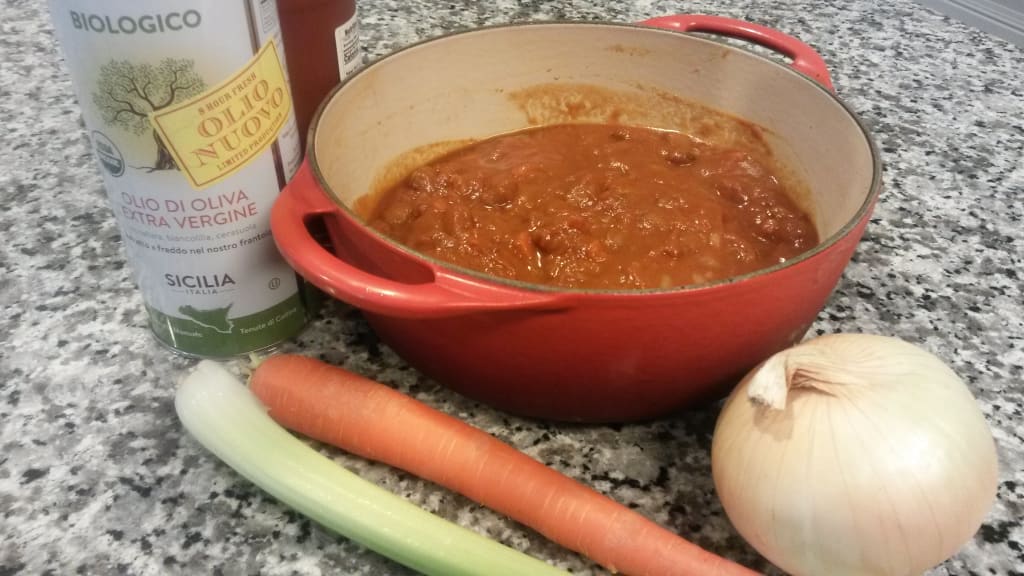Pisarei e faso'
The ultimate comfort food from my childhood in Italy

Waste is a sin. It is the number one rule you learn quickly when you grow up on a farm in Italy, and one you will always abide by, no matter where life takes you, just because it is the right thing to do. Or else. Perhaps this is true of any farm anywhere in the world, since nobody says it openly and directly, but the message is constantly and more or less subtly conveyed in every possible way, in every circumstance, on every occasion, every single day of your life…but it is not as bad as it sounds, really. It is a valuable lesson to learn, considering just how much time and how much work it takes to produce everything from scratch, all the resources and the labor involved, all the efforts and the sacrifices your family and their family had to make in order to get you where you are. This is especially true of food: almost everything you discard has another use, and not all waste is created equal. Sometimes it feeds someone else: every animal on the farm has a category of food “waste” they are assigned to, and you will learn that, too.
Sometimes it is recycled into something else, and that is a whole different layer of expertise you need to learn. In fact, you are worthy of becoming an authentic Italian nonna when you can make a feast out of whatever ingredients you have left in the pantry, especially the unassuming ones which are doomed to be overlooked and discarded sooner or later. For example: what are you going to do with super-stale bread, once it becomes impossible to eat it or once you’ve run out of liquids you can dunk it into? You don’t want to throw it away, do you, after all it takes to make it at home, from scratch, with love, and considering how delicious it is?
And that’s how this recipe begins… with super-stale bread.
Disclaimer from my nonna: this is a “poor” dish, so technically not worthy of being advertised or published. She still does not believe me when I tell her that it is my favorite dish in the whole world. In reality, the vast majority of really good and traditional Italian dishes are poor, which in Italian is synonymous of simple, frugal, hearthy, unrefined and unpretentious, as they were conceived and developed out of necessity, with “poor” ingredients and often by “poor” people, who did not always have a wide range of options to feed their family a nutritious meal. The peasant origin of the dish, and I say it with great pride, is evident in the very name of the dish, pisarei e faso’, which remains un-translated into standard Italian. My nonna is from Piacenza, a town somewhere in the North of Italy, depending on who is talking about it, and pisarei e faso’ is dialect for pisarelli (yep, it doesn’t change that much), a type of fresh pasta, and fagioli (beans), preferably the borlotti variety, because they are easy to find in that area and because, you know, they are just a perfect match with the other ingredients. There are many traditional Italian recipes involving pasta and beans, but this one’s definitely my favorite. I could not think of any other dish I associate with culture and identity as much as this one, or any other dish I enjoy making (and eating) as much as this one. It is the ultimate comfort food for me, but also a dish representing tradition and territory at once.
While this dish is a staple of my cooking routine, I do not make it very often, because I need to make bread first, and then make sure it is stale enough… soft breadcrumbs will not work, and neither will very hard ones. Despite having eaten this dish innumerable times, I have never thought about taking pictures of the process… until I came across this challenge! When I did, I had just made bread, but I am still waiting for it to be stale enough… which is why there are no pictures of the pisarei, for now. You are more than welcome to consult Google Images and see the yumminess for yourself while my bread reaches the perfect degree of staleness and I can start the long but oddly satisfying process of making pisarei by hand, one by one. You can start by making the sauce in advance, like I always do (see pictures) and if you would like to try it first, you can cook another type of pasta with it.
So… here’s the recipe, with a few options and tips, as my nonna would recommend. There are many versions and variations on the theme for this recipe: it can be suitable for vegans, and it can be more or less rich. There are also many “more or less, “to taste”, and “up to you” references, since this is what an Italian nonna will tell you when asked about any of her recipes.
And… It’s in grams, milliliters, and centimeters, of course!
Ingredients (for the pisarei)
200-300 grams of flour (all-purpose will do), depending on how many people you would like to feed
200 grams of breadcrumbs; remember that super-stale bread? This is it.
Some hot water; more or less a cup is my best guess, but it is as much as necessary, depending on the brand of flour and the type of bread. Usually, whatever stale bread you made or have in the house is fine, but remember to make breadcrumbs out of it!
1 egg; although it is possible to omit the egg and follow the vegan path if you so choose… my nonna strongly recommends it, for better texture.
Preparation
1. Make a well with the flour
2. Place the breadcrumbs in the center
3. Pour very small amounts of hot water on the breadcrumbs, until they are soft but not soggy; you can add some flour to adjust the texture, which should be neither too dry nor too sticky
4. Keep adding hot water as you incorporate the flour into the breadcrumbs
5. Once the ingredients start coming together into a dough, add the egg
6. Mix well until a smooth and elastic dough forms; add more water if the dough is too dry, or more flour if it is too sticky
7. Cover the dough with a towel and let it rest for at least 30 minutes
8. In the meantime, you can start preparing the sauce, if you haven’t already done so…
9. Once the dough is “relaxed”, cut the dough into smaller pieces on a lightly floured surface, and roll little dough “snakes” out of each piece. A “snake” of dough for this recipe is roughly as thick as the average pinky, and 10-15 cm long, which is roughly as long as the average hand.
10. Cut each “snake” into 10-15 smaller pieces, about 1-2 cm each, depending on how small or how big you want your pisarei to be... I like mine a little chunky, so I make the snakes longer and the pisarei thicker.
11. Using your thumb, press each piece as you roll it into a small curl; it is like making gnocchi, but smaller and without using any tool.
A little word of wisdom from my nonna: do not be discouraged if the first ones do not look great… it takes a lot of practice to make perfect pisarei, and even the awkward ones taste just as amazing as the others!
Ingredients (for the sauce, which “leads” the dish, nonna says)
Soffritto… the key for success when making many Italian dishes on a stovetop, don’t tell anyone. Here’s the most basic and traditional version:
2-3 tbps of extra virgin olive oil (buy a good one, you won’t regret it)
1 small onion
1 small carrot
1 small stalk of celery
All the vegetables should be chopped as finely as possible, including the fresh chili peppers if you choose to add them.
200-300 grams of borlotti beans; if you can’t find them, you can use Pinto beans, instead, but it’s really not the same. You can use fresh or dry beans, but you will need to soak the dry beans overnight before you can use them.
400-500 ml of tomato “passata” (better if home-made, of course); this is NOT tomato sauce, it is just strained or pureed tomatoes with salt and sometimes a little bit of sugar… you can find it almost everywhere in a good supermarket or in a specialty store, but if you read any other ingredient beside the ones listed above, don’t buy it, it’s another fake Italian product... and it should come in a glass bottle! Do not buy canned passata, it’s terrible.
100 grams of pancetta (a type of Italian cured meat, you can use fresh bacon if you cannot find it), which is also optional, if you would like to keep your sauce vegan, or simply less rich.
Salt and pepper to taste.
Nonna’s secret ingredient: finely chopped rosemary (which I hate and never use, but it is totally up to you whether to add the extra tang or not)
For spicy food lovers! If you would like to spice up this recipe, like I usually do, definitely add fresh chili peppers or chili pepper flakes to the soffritto!
Preparation
1. Make the soffritto by heating up the oil in a Dutch oven or a large and deep skillet, and add the chopped onion, celery, and carrot (and the chili peppers if you are using them).
2. Let the vegetables sweat for 3-5 minutes, or until fragrant, and add the pancetta, if you are using it. It is very tasty, but it won’t make or break the recipe… in my opinion.
3. Add the tomato sauce, stir well, and bring to a boil.
4. Add the beans and a life hack*, and reduce to a simmer. Life hack*: as you empty the bottle of passata, you will notice that there is always some left… add some hot water to it, and keep it on the side as the sauce cooks. You will need to add a little bit of that to the sauce regularly.
5. Cover and let the sauce cook on low heat for at least one hour, and up to two hours for a thicker sauce, or if the beans are still undercooked, which is very likely to happen especially if you are not using fresh ones.
6. Remember to regularly check on the sauce… if it thickens too much, add more of the life hack (see above) as you go, but if it is not simmering, turn on the heat a little bit. The ideal texture for this dish should be on the thick side, but it should also allow for the pisarei e faso’ to be a little soupy.
Assembling the dish
1. Fill a large pot with water, and bring to a boil
2. Add salt and “throw” the pisarei in; basically, cook them as you would cook any other type of pasta (see picture as an example), but keep in mind that fresh pasta cooks much faster, especially if you made small pisarei.
3. After 5 minutes, try one or two pisarei to check on the texture… we like our pasta al dente, of course, but you can cook it a little bit longer if you don’t like your pasta to be too chewy, or if you are not used to it
4. Drain the pisarei and add them to the sauce; mix and stir on low heat for 4-5 minutes, until the pisarei and the faso’ are well distributed and have evenly absorbed the sauce
5. BUON APPETITO!
About the Creator
Enjoyed the story? Support the Creator.
Subscribe for free to receive all their stories in your feed. You could also pledge your support or give them a one-off tip, letting them know you appreciate their work.






Comments
There are no comments for this story
Be the first to respond and start the conversation.